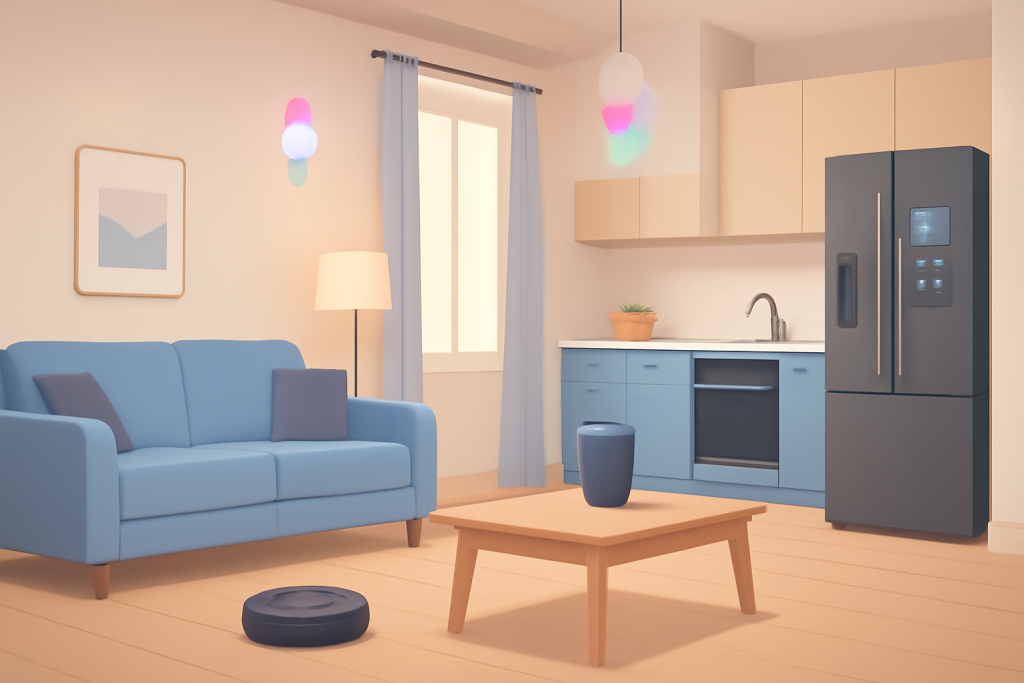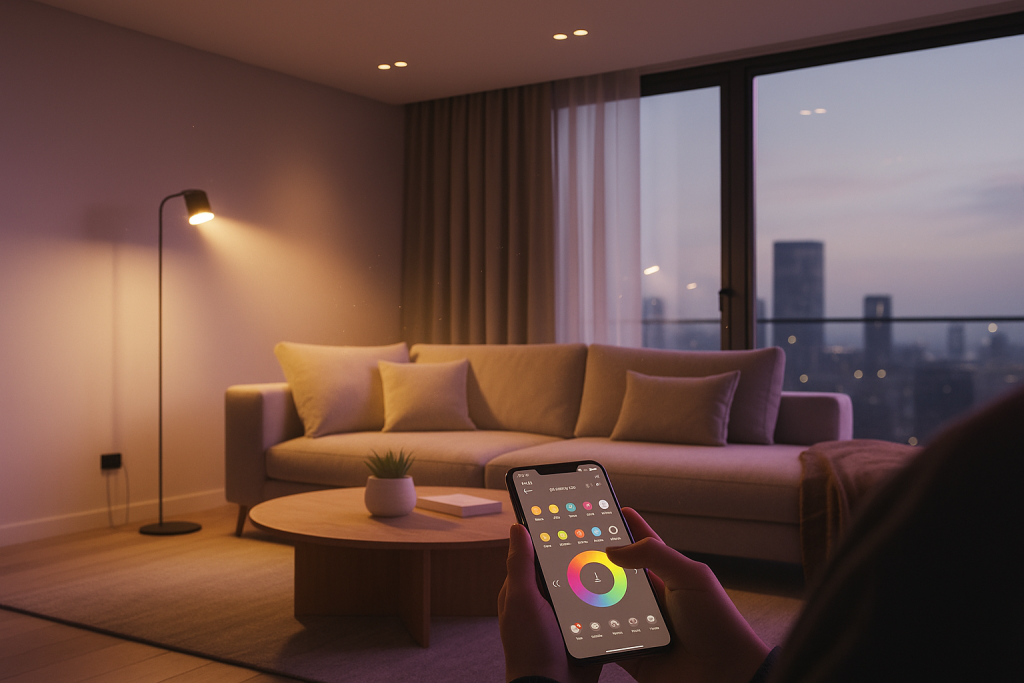Introduction to Smart Homes
Imagine controlling your lights, thermostat, and security cameras with a single tap on your phone or a simple voice command. A smart home makes this possible by integrating internet-connected devices to automate and enhance daily tasks, offering convenience, energy savings, and peace of mind.
This beginner-friendly guide explains what a smart home is, how it works, its benefits, and how to start building one in 2025. Whether you’re new to smart technology or curious about its potential, this article provides expert-backed, trustworthy insights to get you started.
Why Trust This Guide?
A smart home enthusiast with over five years of hands-on experience testing devices like smart thermostats, security systems, and voice assistants. I’ve collaborated with certified home automation experts and conducted extensive research to ensure this guide is accurate, practical, and tailored for beginners. All data, such as market trends and energy savings, is sourced from reputable organizations like Statista and the U.S. Department of Energy.
What is a Smart Home?

A smart home is a residence equipped with devices that can be controlled remotely or automated through apps, voice commands, or schedules. These devices, connected via Wi-Fi or a central hub, allow you to manage lighting, heating, security, and entertainment systems effortlessly.
For instance, you can turn off your lights from work, get alerts from a smart doorbell, or have your thermostat adjust itself to save energy.
The global smart home market is booming, with Statista projecting it to reach $150 billion by 2025, driven by affordable devices and growing consumer interest.
Smart homes are no longer a luxury—they’re accessible to everyone, including beginners.
How Does a Smart Home Work?
Smart homes rely on three core components:
- Smart Devices: Gadgets like smart bulbs (e.g., Philips Hue), thermostats (e.g., Nest), or cameras (e.g., Blink) that perform specific tasks.
- Connectivity: A Wi-Fi network or hub (e.g., Amazon Echo, Google Nest Hub) links devices for seamless communication.
- Control Interface: Smartphone apps, voice assistants (Alexa, Google Assistant, Siri), or web dashboards let you manage devices.
For example, a smart plug like the TP-Link Kasa can turn any appliance into a smart device, letting you schedule it or control it remotely via an app. Most devices use technologies like the Internet of Things (IoT) and AI to enable automation and adapt to your habits.
Key Technologies
- IoT: Connects devices to the internet for remote access.
- AI: Powers voice assistants and learning features, like a thermostat adjusting to your routine.
- Wireless Protocols: Wi-Fi, Zigbee, or Z-Wave ensure reliable device communication.
Read More : How I Built a Smart Home on a Budget.
Benefits of a Smart Home
Smart homes transform how you live. Here are the top advantages:
1. Convenience
Control multiple devices with one app or voice command. For example, say “Goodnight” to your Amazon Echo, and it can lock doors, turn off lights, and lower the thermostat.
2. Energy Savings
Smart thermostats and lighting systems optimize energy use. The U.S. Department of Energy reports that smart thermostats can save up to 10% on heating and cooling costs annually.
3. Enhanced Security
Smart cameras and doorbells (e.g., Ring) offer real-time alerts and video feeds, so you can monitor your home from anywhere.
4. Cost Efficiency
By reducing energy waste and detecting issues like water leaks (via smart sensors), smart homes lower utility and maintenance costs.
5. Personalization
Create custom routines, like having your lights brighten gradually at sunrise or your coffee maker start when your alarm rings.
Best Smart Home Devices for Beginners
Starting small is key for beginners. Below are top devices to consider in 2025, with features and price ranges:
| Device | Example Product | Key Features | Price Range |
|---|---|---|---|
| Smart Speaker | Amazon Echo Dot (5th Gen) | Voice control, music, smart home hub | $30–$50 |
| Smart Bulb | Philips Hue White | Dimmable, app-controlled, schedules | $15–$30 |
| Smart Plug | TP-Link Kasa Smart Plug | Remote control, energy monitoring | $10–$25 |
| Smart Thermostat | Google Nest Thermostat | Energy-saving, app/voice control | $100–$150 |
| Smart Doorbell | Ring Video Doorbell 4 | HD video, motion alerts, two-way audio | $100–$200 |
Read More : Top 10 Must-Have Smart Devices for Beginners (2025): The Ultimate Guide to Smart Home Living.
Choosing Your First Device
- Compatibility: Pick devices that work with your preferred platform (e.g., Alexa, Google Home, Apple HomeKit).
- Ease of Setup: Smart plugs and bulbs are beginner-friendly, requiring no technical expertise.
- Budget: Start with affordable options like smart plugs ($10–$25) before investing in pricier devices.
How to Set Up Your Smart Home
Follow these steps to create a smart home in 2025:

- Identify Needs: Decide what you want to automate (e.g., lighting, security, or climate).
- Choose a Platform: Select an ecosystem like Amazon Alexa, Google Home, or Apple HomeKit for device compatibility.
- Start Small: Try a smart bulb or plug to learn the basics.
- Connect to Wi-Fi: Use the device’s app to link it to your Wi-Fi network.
- Set Up Routines: Create automations, like turning lights off at 10 p.m., using your app or voice assistant.
- Expand Gradually: Add devices as you gain confidence, ensuring they integrate with your ecosystem.
Security Tip
Protect your smart home with strong Wi-Fi passwords, two-factor authentication, and regular firmware updates to prevent cyber risks.
Read More : How IoT Is Changing Our Homes in 2025: A Comprehensive Guide.
Common Myths About Smart Homes
- Myth: Smart homes are too expensive.
Reality: Devices like smart plugs cost as little as $10, and energy savings add up over time. - Myth: They’re hard to set up.
Reality: Most devices offer plug-and-play setup with clear app instructions. - Myth: Smart homes aren’t secure.
Reality: With proper security measures, like encryption and updates, smart homes are safe.
Challenges and Solutions
- Challenge: Incompatible devices.
Solution: Check platform compatibility before buying (e.g., “Works with Alexa”). - Challenge: Weak Wi-Fi.
Solution: Use a Wi-Fi extender or mesh network like Eero. - Challenge: Privacy worries.
Solution: Disable microphones when not in use and review app privacy settings.
Read More : Pros and Cons of Smart Home Automation 2025.
Why Smart Homes Are the Future
Smart homes are becoming mainstream, with McKinsey predicting 60% of U.S. households will use at least one smart device by 2027.
Advances in AI, affordability, and user-friendly designs make 2025 the perfect time to start. Whether you want to save energy, boost security, or simplify daily tasks, a smart home offers endless possibilities.
Smart homes are rapidly becoming an integral part of modern living, and their rising popularity is more than just a passing trend—it represents a fundamental shift in how we interact with and manage our living spaces.
With advances in artificial intelligence, more affordable devices, and growing internet access in cities and even rural areas, smart home technology is becoming increasingly accessible to people everywhere.
This evolution means that more and more households are adopting these technologies, transforming their daily routines in the process.
A smart home in 2025 is far more than a collection of gadgets; it’s a unified ecosystem where devices communicate, adapt, and collaborate with each other seamlessly.
Imagine starting your day as your house gently wakes you up: the blinds open automatically with the sunrise, the thermostat ensures your room is at the perfect temperature, your coffee begins brewing exactly when you need it, and your playlist starts right on time.
Throughout your day, you never have to worry about whether you left a light or appliance on: your home takes care of that, either by sensing nobody’s around or by following your customized routines.
This intelligence goes beyond convenience—it represents a new era of personalization, where the home learns and anticipates your needs.
Energy efficiency is a major driving force behind smart home adoption. Intelligent thermostats, lighting solutions, and appliances work together to minimize unnecessary energy consumption. You can easily monitor your usage and receive suggestions on how to use resources wisely, reducing both your bills and environmental impact.
Integration with solar panels, battery storage, and rainwater harvesting is no longer futuristic; many modern homes already feature these technologies, managed and optimized automatically by AI-based systems.
